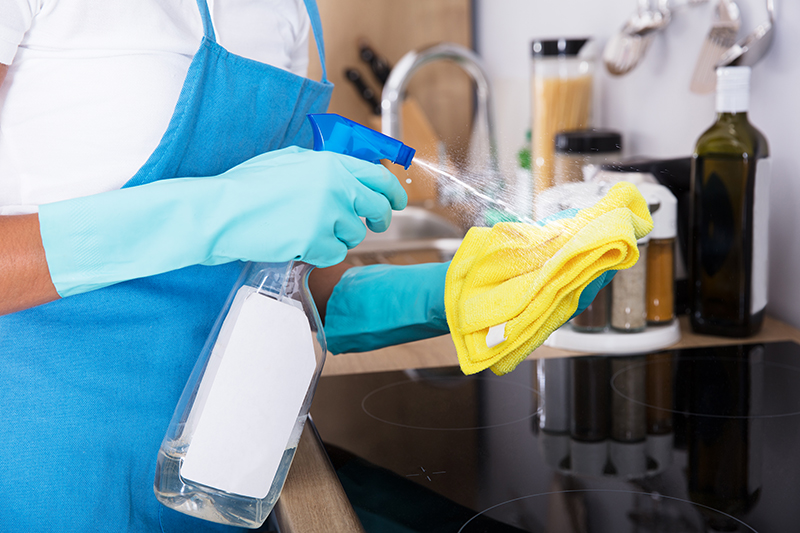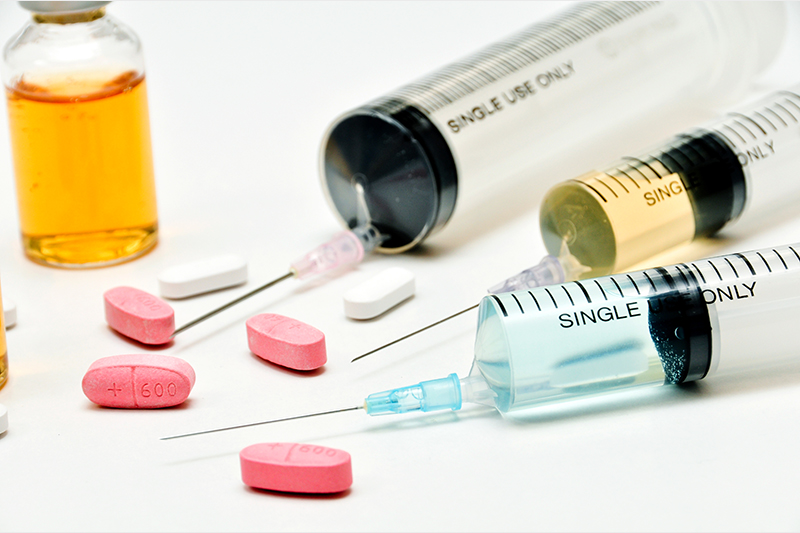




Working in a care setting will sometimes lead to using substances that could be hazardous to health, thus putting people at risk. Elderly clients may be more vulnerable to infections and to harm from spillages and other accidents.
The law requires employers to control exposure to hazardous substances in order to protect both employees and others who may be exposed. Employers need to comply with the Control of Substances Hazardous to Health (COSHH) regulations.
The Government list of hazardous substances includes:
The hazards relating to these substances can vary depending on work settings.
Under the COSHH law managers of care homes must assess the health risks to the staff, residents and visitors, and take action to prevent or control exposure to hazardous substances, infections and diseases.
Managers must establish what substances and biological hazards are present and how they can cause harm. Cleaning Products, hazardous substances and soiled laundry present problems in care homes and managers must ensure the risks are minimised.
There are some cleaning products that can be replaced with safer products containing less irritants. If substitution is not possible then the potential for exposure must be reduced by ensuring there are safe systems for handling the substances, following manufacturer instructions, and by securely storing products. Cleaning products must be kept in their original containers, and the correct personal protective equipment (PPE) should be worn.
Product hazard warnings may be found on labels, which for hazardous substances may include risk phrases such as ‘avoid contact with skin’. If the information is not readily available on the label or an advisory leaflet, then managers should obtain a data sheet for that product from the supplier or manufacturer. PPE should be provided if it is not reasonably practicable to prevent or otherwise control the risk.
The PPE provided should be suitable for the product and task following the product instructions. Toilet cleaning chemicals may only require the use of rubber gloves, whereas caustic descalers and oven cleaners may require heavy-duty gloves, goggles or face shields and a well-ventilated area while the products are being used. Many of the risks for hazardous substances used in a care home can be grouped together when considering suitable control measures.
The manager must ensure that staff are given information, instruction and training on how to use and store the product safely, how to clear up spillages, and how to check and wear protective equipment correctly.
Weithiau, bydd gweithio mewn lleoliad gofal yn arwain at ddefnyddio sylweddau a allai fod yn beryglus i iechyd, gan roi pobl mewn perygl. Gall cleientiaid oedrannus fod yn fwy agored i heintiau ac i niwed oherwydd gorlifiadau a damweiniau eraill.
Mae'r gyfraith yn ei gwneud yn ofynnol i gyflogwyr reoli amlygiad i sylweddau peryglus er mwyn diogelu gweithwyr cyflogedig ac eraill a allai gael eu hamlygu. Mae angen i gyflogwyr gydymffurfio â Rheoliadau Rheoli Sylweddau Peryglus i Iechyd (COSHH).
Mae rhestr y Llywodraeth o sylweddau peryglus yn cynnwys:
Gall y peryglon sy'n gysylltiedig â'r sylweddau hyn amrywio yn dibynnu ar leoliadau gwaith.
O dan y gyfraith COSHH mae'n rhaid i reolwyr cartrefi gofal asesu'r risgiau iechyd i'r staff, y preswylwyr ac ymwelwyr, a chymryd camau i atal neu reoli amlygiad i sylweddau peryglus, heintiau a chlefydau.
Rhaid i reolwyr sefydlu pa sylweddau a pheryglon biolegol sy'n bresennol a sut y gallant achosi niwed. Mae cynhyrchion glanhau, sylweddau peryglus a dillad budr yn achosi problemau mewn cartrefi gofal a rhaid i reolwyr sicrhau bod y risgiau'n cael eu lleihau.
Mae rhai cynhyrchion glanhau y gellir eu disodli gyda chynhyrchion mwy diogel sy'n cynnwys llai o gyfryngau llidus. Os nad yw'n bosibl eu cyfnewid, yna rhaid lleihau'r potensial o amlygu trwy sicrhau bod systemau diogel ar gyfer trin y sylweddau, yn dilyn cyfarwyddiadau'r gwneuthurwr, a thrwy storio cynhyrchion yn ddiogel. Rhaid cadw cynhyrchion glanhau yn eu cynwysyddion gwreiddiol, a dylid gwisgo'r cyfarpar diogelu personol cywir (PPE).
Gellir dod o hyd i rybuddion am beryglon cynnyrch ar labeli, a all gynnwys ymadroddion risg fel 'dylid osgoi cyswllt â chroen' ar gyfer sylweddau peryglus. Os nad yw'r wybodaeth ar gael yn hawdd ar y label neu ar daflen gynghori, dylai rheolwyr gael dalen data ar gyfer y cynnyrch hwnnw gan y cyflenwr neu'r gwneuthurwr. Dylid darparu PPE os nad yw'n rhesymol ymarferol i atal neu reoli'r risg mewn ffordd arall.
Dylai'r PPE a ddarperir fod yn addas ar gyfer y cynnyrch a'r dasg yn dilyn cyfarwyddiadau'r cynnyrch. Efallai mai dim ond menig rwber y bydd angen eu defnyddio ar gemegau glanhau'r toiled, ond mae'n bosibl y bydd angen menig gwaith trwm, gogls neu orchudd wyneb ar gyfer glanhawyr popty, a man wedi'i awyru'n dda tra bod y cynhyrchion yn cael eu defnyddio. Gellir grwpio llawer o'r risgiau ar gyfer sylweddau peryglus a ddefnyddir mewn cartref gofal gyda'i gilydd wrth ystyried mesurau rheoli addas.
Rhaid i'r rheolwr sicrhau bod staff yn cael gwybodaeth, cyfarwyddyd a hyfforddiant ar sut i ddefnyddio a storio'r cynnyrch yn ddiogel, sut i glirio gorlifiadau, a sut i wirio a gwisgo'r cyfarpar amddiffynnol yn gywir.
Warning! This resource is not optimised for use on mobile devices.
Rhybudd! Ni ellir defnyddio’r adnodd yma ar ffonau symudol neu dabled.
Drag the hazard to the correct symbol.
Llusgwch y perygl at y symbol cywir.
Well done. You have matched them all correctly.
Da iawn. Rydych wedi paru pob un yn gywir.
COSHH symbol Symbol COSHH |
Hazard Perygl |
Correct answers Atebion cywir |
|---|

Health and Social Care organisations have many hazardous substances that could cause harm to staff, service users or visitors.
Hazards in relation to substances are mostly centred on the preparation of food products and the risk from poor cleaning, unsafe handling and storage of food products.
Staff must be trained to be aware of how to handle and dispose of equipment correctly as bodily fluids and sharp objects such as needles to administer medication can also cause harm to people.
Mae gan sefydliadau iechyd a gofal cymdeithasol lawer o sylweddau peryglus a allai achosi niwed i staff, defnyddwyr gwasanaeth neu ymwelwyr.
Mae peryglon mewn perthynas â sylweddau yn canolbwyntio'n bennaf ar baratoi cynhyrchion bwyd a'r perygl o lanhau gwael, a thrin a storio cynhyrchion bwyd yn anniogel.
Mae'n rhaid i staff gael eu hyfforddi i fod yn ymwybodol o sut i drin a chael gwared ar gyfarpar yn gywir gan fod hylifau corfforol a gwrthrychau miniog fel nodwyddau i weini meddyginiaeth hefyd yn gallu achosi niwed i bobl.
Identify the good practice in each picture before comparing with the suggested answer.
Nodwch yr arfer da ym mhob llun cyn cymharu â'r ateb awgrymedig.
Staff must have regular training in order to ensure they are aware of any hazardous substances in their workplace. Staff must know how to store medication and cleaning products correctly, how to dispose of waste products and protect themselves by using personal protective clothing.
Mae'n rhaid i staff gael hyfforddiant rheolaidd er mwyn sicrhau eu bod yn ymwybodol o unrhyw sylweddau peryglus yn eu gweithle. Rhaid i staff wybod sut i storio meddyginiaeth a chynhyrchion glanhau yn gywir, sut i gael gwared ar gynhyrchion gwastraff a'u hamddiffyn eu hunain drwy ddefnyddio dillad amddiffynnol personol.
Consider the following nurse’s role and the policies of the care home where she is working in order to protect herself and others around her.
Drag the correct words to the gaps in the text.
Ystyried rôl y nyrs ganlynol a pholisïau'r cartref gofal lle mae'n gweithio er mwyn amddiffyn ei hun ac eraill o'i hamgylch.
Llusgwch y geiriau cywir i'r bylchau yn y testun.
Debbie is a nurse in a nursing home caring for elderly residents mostly with Alzheimer’s which means they are very forgetful and confused at times. Because of this reason they are unable to manage their medication and they could take it incorrectly. To prevent this the staff including Debbie must ensure that all medication is stored correctly in a locked cupboard. This is the same for all other substances that could harm them, such as cleaning products.
Debbie has to change a dressing on the leg of one of the residents as she has a wound that is not healing very well and has become infected. There is a strict procedure Debbie needs to follow to ensure this is done correctly without spreading any infection to other residents. She makes sure she washes her hands then puts on personal protective clothing, which includes a disposable apron and gloves. This will protect her and reduce the risk of spreading the infection to other people. She removes the dirty bandage and places it in an appropriate yellow bag which is labelled “clinical waste”, she then cleans the wound and puts a new bandage on before removing her gloves and apron and placing them also in the “clinical waste” yellow bag. This will tell the cleaners that special precautions must be taken to dispose of the yellow bag without spreading infection. Debbie then washes her hands again before getting on with her other duties.
Debbie is a nurse in a nursing home caring for elderly residents mostly with Alzheimer’s which means they are very forgetful and confused at times. Because of this reason they are unable to manage their medication and they could take it incorrectly. To prevent this the staff including Debbie must ensure that all medication is stored correctly in a locked cupboard. This is the same for all other substances that could harm them, such as cleaning products.
Debbie has to change a dressing on the leg of one of the residents as she has a wound that is not healing very well and has become infected. There is a strict procedure Debbie needs to follow to ensure this is done correctly without spreading any infection to other residents. She makes sure she washes her hands then puts on personal protective clothing, which includes a disposable apron and gloves. This will protect her and reduce the risk of spreading the infection to other people. She removes the dirty bandage and places it in an appropriate yellow bag which is labelled “clinical waste”, she then cleans the wound and puts a new bandage on before removing her gloves and apron and placing them also in the “clinical waste” yellow bag. This will tell the cleaners that special precautions must be taken to dispose of the yellow bag without spreading infection. Debbie then washes her hands again before getting on with her other duties.
You scored … out of . Move some of the terms around to try to improve your score.
Well done. You scored … out of .
You scored … out of . Click reset to try the activity again.
You scored … out of . Move some of the terms around to try to improve your score.
Well done. You scored … out of .
You scored … out of . Click reset to try the activity again.
Mae Debbie yn nyrs mewn cartref nyrsio sy'n gofalu am breswylwyr oedrannus gyda chlefyd Alzheimer yn bennaf, sy'n golygu eu bod yn anghofus iawn ac yn ddryslyd ar adegau. Oherwydd hyn nid ydynt yn gallu rheoli eu meddyginiaeth a gallent ei chymryd yn anghywir. Er mwyn atal hyn mae'n rhaid i'r staff, gan gynnwys Debbie, sicrhau bod yr holl feddyginiaeth yn cael ei storio'n gywir mewn cwpwrdd dan glo. Mae'r un peth yn wir am bob sylwedd arall a allai eu niweidio, fel cynhyrchion glanhau.
Mae'n rhaid i Debbie newid dresin ar goes un o'r trigolion gan fod ganddi glwyf nad yw'n gwella'n dda iawn ac sydd wedi dod yn heintiedig. Mae gweithdrefn lem mae angen i Debbie ei dilyn er mwyn sicrhau bod hyn yn cael ei wneud yn gywir heb ledaenu unrhyw haint i breswylwyr eraill. Mae'n gwneud yn siŵr ei bod yn golchi ei dwylo ac yna'n rhoi dillad amddiffynnol personol ymlaen, sy'n cynnwys ffedog a menig tafladwy. Bydd hyn yn ei hamddiffyn ac yn lleihau'r perygl o ledaenu'r haint i bobl eraill. Mae'n tynnu’r rhwymyn budr ac yn ei roi mewn bag melyn priodol sydd wedi ei labelu fel "gwastraff clinigol", mae hi wedyn yn glanhau'r clwyf ac yn rhoi rhwymyn newydd arno cyn tynnu ei menig a'i ffedog a'u gosod hefyd yn y bag melyn "gwastraff clinigol". Bydd hyn yn dweud wrth y glanhawyr bod yn rhaid cymryd rhagofalon arbennig i waredu'r bag melyn heb ledaenu haint. Yna, mae Debbie yn golchi ei dwylo eto cyn bwrw ymlaen â'i dyletswyddau eraill.
Mae Debbie yn nyrs mewn cartref nyrsio sy'n gofalu am breswylwyr oedrannus gyda chlefyd Alzheimer yn bennaf, sy'n golygu eu bod yn anghofus iawn ac yn ddryslyd ar adegau. Oherwydd hyn nid ydynt yn gallu rheoli eu meddyginiaeth a gallent ei chymryd yn anghywir. Er mwyn atal hyn mae'n rhaid i'r staff, gan gynnwys Debbie, sicrhau bod yr holl feddyginiaeth yn cael ei storio'n gywir mewn cwpwrdd dan glo. Mae'r un peth yn wir am bob sylwedd arall a allai eu niweidio, fel cynhyrchion glanhau.
Mae'n rhaid i Debbie newid dresin ar goes un o'r trigolion gan fod ganddi glwyf nad yw'n gwella'n dda iawn ac sydd wedi dod yn heintiedig. Mae gweithdrefn lem mae angen i Debbie ei dilyn er mwyn sicrhau bod hyn yn cael ei wneud yn gywir heb ledaenu unrhyw haint i breswylwyr eraill. Mae'n gwneud yn siŵr ei bod yn golchi ei dwylo ac yna'n rhoi dillad amddiffynnol personol ymlaen, sy'n cynnwys ffedog a menig tafladwy. Bydd hyn yn ei hamddiffyn ac yn lleihau'r perygl o ledaenu'r haint i bobl eraill. Mae'n tynnu’r rhwymyn budr ac yn ei roi mewn bag melyn priodol sydd wedi ei labelu fel "gwastraff clinigol", mae hi wedyn yn glanhau'r clwyf ac yn rhoi rhwymyn newydd arno cyn tynnu ei menig a'i ffedog a'u gosod hefyd yn y bag melyn "gwastraff clinigol". Bydd hyn yn dweud wrth y glanhawyr bod yn rhaid cymryd rhagofalon arbennig i waredu'r bag melyn heb ledaenu haint. Yna, mae Debbie yn golchi ei dwylo eto cyn bwrw ymlaen â'i dyletswyddau eraill.
Mae gennych … allan o yn gywir. Symudwch rhai o'r termau o gwmpas i geisio gwella eich sgôr.
Da iawn. Mae gennych … allan o yn gywir.
Mae gennych … allan o yn gywir. Cliciwch ‘ailosod’ er mwyn rhoi cynnig arall ar y gweithgaredd.
Mae gennych … allan o yn gywir. Symudwch rhai o'r termau o gwmpas i geisio gwella eich sgôr
Da iawn. Mae gennych … allan o yn gywir.
Mae gennych … allan o yn gywir. Cliciwch ‘ailosod’ er mwyn rhoi cynnig arall ar y gweithgaredd.